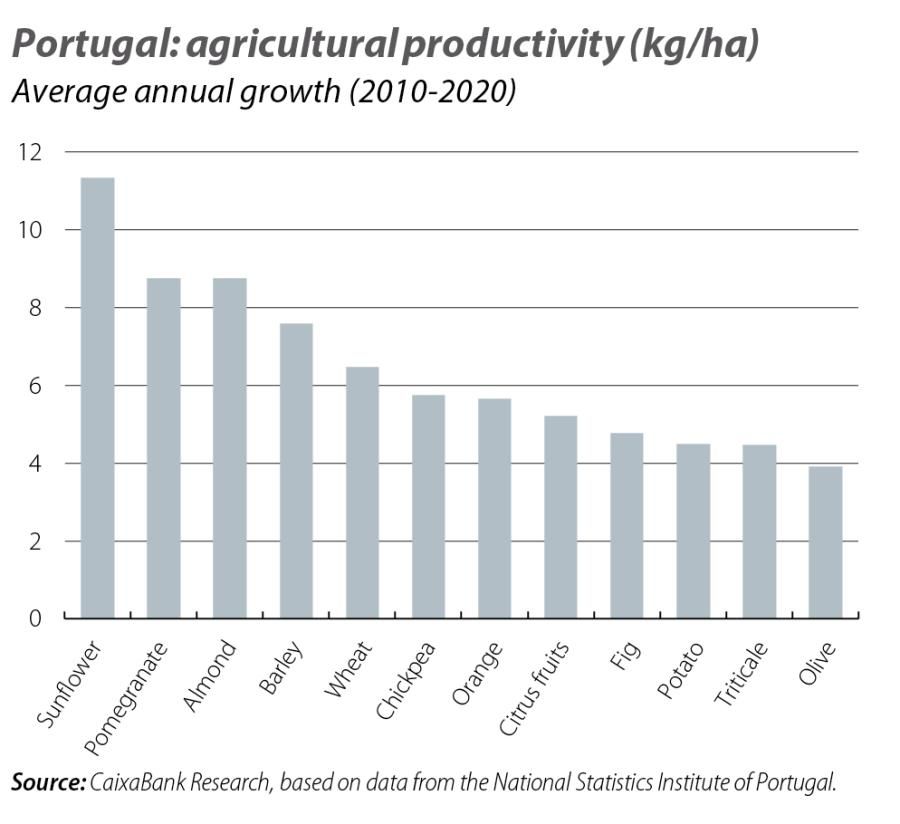The agrifood sector in Portugal (part I): strong post-pandemic recovery

Production in the agrifood sector1 accounts for almost 8% of national production, with the food industry alone accounting for 4.3% of total production and representing over half of that of the sector.
Like other parts of the economy, the agrifood sector has been hit hard by the pandemic, but it has also experienced a buoyant recovery.
Starting with the primary sector, the loss of GVA in 2020, of almost 6%, had already been recovered in the first three quarters of 2021. As such, it outperformed the economy as a whole, which in 2020 shrunk by 8.4% and in September 2021 was still 5.1% below the level of September 2019. This strong performance is also reflected in the agricultural production data (including agricultural and livestock production), which according to estimates by the National Statistics Institute registered a 6.7% increase in 2020 at constant prices, after a practically stagnant 2020. Plant-based products made a particularly significant contribution to this performance, representing around 61% of agricultural production and registering 10% growth. Within this category, the growth rates were particularly high in the production of fruit, horticultural products and wine; accounting for 22%, 12% and 10% of agricultural production, respectively, these items registered growth rates of 14.5%, 14% and 5% in 2021. In animal production (34% of agricultural production), cattle and pig breeding and milk production stand out.
- 1. It includes agriculture, food production, hunting and related services, and the agrifood industry, which encompasses the food, beverage and tobacco sectors.

Production in the agrifood industry (which accounts for 10% of the manufacturing sector) shows a more marked recovery in the food segment than in the case of beverages. Up to November, beverage production was still 9% below 2019 production levels, while food production was just 1% below (5% for the manufacturing industry overall). The trend in turnover shows a similar but less benign pattern: the food industry up to November was already 2.1% above 2019, while the turnover in beverages was still 1.8% below.

Employment remains below pre-COVID levels in both manufacturing segments: 6% below for the food industry and 2.5% below in the case of beverages (3% below in the manufacturing industry overall). In the primary sector, despite the estimated increase in output, employment in 2021 remained 1.3% below the 2019 level, reflecting the 2% drop in employment among non-wage earners and a very slight increase among wage earners.

This trend in the primary sector reflects structural changes, especially the greater entrepreneurialization of the sector. Between 2009 and 2019, the number of companies operating in the sector more than doubled (+115.5%), reaching 14,604, 48% of which have more than 20 hectares of land. Of course, the professionalisation of the sector results in improvements in production through increased mechanisation of agricultural activities, especially the use of advanced precision farming technologies.2 It also results in a reduction of labour (–14.4% between 2009 and 2019), leading to a significant increase in productivity. In the last five years this increase has been particularly pronounced in the cultivation of sunflower, pomegranate, almond and berry crops, especially blackberries and blueberries.
- 2. The use of georeferenced data (using satellites, drones, sensors and other tools) that enable targeted interventions that are differentiated by zone (the application of fertilisers or plant-protection products, irrigation, sowing/ plantations, etc.). Although the use of these technologies is still marginal, as only 0.3% of farms claim to use them, the land area and livestock units that are associated with these farms (and that are potentially benefiting from these technologies) are much greater: 4.2% of utilised agricultural land and 1.6% of all livestock units belong to farms with access to such data (of which 2.3% and 0.8%, respectively, use them to plan their farming operations). (National Statistics Institute, 2021 agricultural census).

The strong performance of the agrifood sector is particularly noticeable in international trade. After having exported 2.3% more in 2020 than in 2019 in the first 11 months of 2021 the value exported exceeded pre-pandemic levels, a much stronger growth pattern than that recorded in the total export of goods (5.2%). Imports also increased, but more moderately (by 4.7% on a cumulative basis up to November), which allowed the sector’s trade deficit to be reduced by some 400 million euros to 31 billion.
The main destination of the country’s agrifood exports is Spain (35% of total exports), followed by France (11%), Italy (6.5%) and Brazil (5%); and almost half (47.4%) of those exports are from the food and beverage industries, followed by live animals (22%) and agricultural products (19.5%).
As of late 2021, with the year almost at an end, virtually all products of the agrifood sector exceeded pre-pandemic levels, with wine, oil and horticultural products representing the largest items among exports. Exports of goods such as milk and milk-based products, meat (especially pork) and live animals also registered strong growth in 2021, as did exports of processed food products.
In short, 2021 was a good year for the agrifood sector, placing it in a better position to meet the challenges ahead, particularly with regard to meeting the objectives of the European Green Deal – a topic we will address in a forthcoming article.
- 1. It includes agriculture, food production, hunting and related services, and the agrifood industry, which encompasses the food, beverage and tobacco sectors.
- 2. The use of georeferenced data (using satellites, drones, sensors and other tools) that enable targeted interventions that are differentiated by zone (the application of fertilisers or plant-protection products, irrigation, sowing/ plantations, etc.). Although the use of these technologies is still marginal, as only 0.3% of farms claim to use them, the land area and livestock units that are associated with these farms (and that are potentially benefiting from these technologies) are much greater: 4.2% of utilised agricultural land and 1.6% of all livestock units belong to farms with access to such data (of which 2.3% and 0.8%, respectively, use them to plan their farming operations). (National Statistics Institute, 2021 agricultural census).


